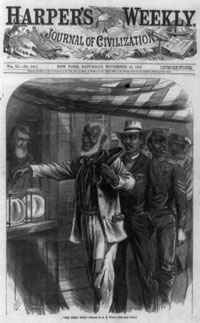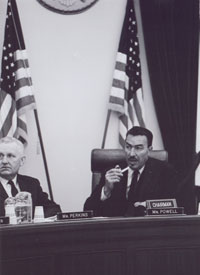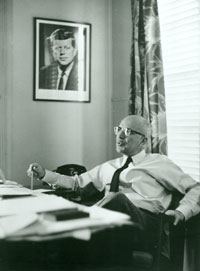Black Americans in Congress: An Introduction
Introduction
 An 1867 Harper’s Weekly cover commemorates the first vote cast by African-American men. The passage and ratification of the Reconstruction Amendments (13th, 14th, and 15th) between 1865 and 1870 catapulted former slaves from chattel to voters and candidates for public office.Image courtesy of Library of Congress
An 1867 Harper’s Weekly cover commemorates the first vote cast by African-American men. The passage and ratification of the Reconstruction Amendments (13th, 14th, and 15th) between 1865 and 1870 catapulted former slaves from chattel to voters and candidates for public office.Image courtesy of Library of CongressThe arrival of Senator Hiram Revels of Mississippi and Representative Joseph Rainey of South Carolina on Capitol Hill in 1870 ranks among the great paradoxes in American history; just a decade earlier, these African Americans’ congressional seats were held by southern slave owners. Moreover, the U.S. Capitol, where these newest Members of Congress came to work—the center of legislative government, conceived by its creators as the “Temple of Liberty”—had been constructed with the help of enslaved laborers.1 From this beginning, Black Americans in Congress, 1870–2007 chronicles African Americans’ participation in the federal legislature and their struggle to attain full civil rights.
The institution of Congress, and the careers of the black Members who have served in both its chambers, have undergone extensive changes during this span of nearly 140 years.2 But while researching and writing this book, we encountered several recurring themes that led us to ask the following questions: What were black Members’ legislative priorities? Which legislative styles did African Americans employ to integrate into the institution? How did they react to the political culture of Capitol Hill and how did they overcome institutional racism? Lastly, how did the experiences of these individuals compare to those of other newly enfranchised Americans?
Shared Experiences of Black Americans in Congress
In striking aspects, the history of blacks in Congress mirrors that of other groups that were new to the political system. Throughout African-American history in Congress, Members viewed themselves as “surrogate” representatives for the black community nationwide rather than just within the borders of their individual districts or states.3 George White of North Carolina (1897–1901) and Robert Elliott of South Carolina (1871–1874) first embodied these roles, serving as models for 20th-century black Members such as Oscar De Priest of Illinois (1929–1935), Adam Clayton Powell, Jr., of New York (1945–1971), and Shirley Chisholm of New York (1969–1983). Surrogate representation was not limited to black Members of Congress; nearly half a century after blacks entered Congress, woman Members, too, grappled with the added burdens of surrogate representation. In 1917, women throughout the country looked to the first woman to serve in Congress, Representative Jeannette Rankin of Montana, for legislative support. Indeed, Rankin received so many letters she was forced to hire additional secretaries to handle the workload.4
Twentieth-century African-American pioneers’ experience was similar in some respects to that of women.5 Known and admired by blacks nationally, Representative De Priest and those who followed him were often sought out by individuals across the country, many of whom expected unfailing receptiveness to the long-neglected needs of the black community. In late 1934, the Atlanta Daily World memorialized De Priest, who lost re-election in his Chicago-centered district to Arthur W. Mitchell (1935–1943), the first black Democrat to serve in Congress. De Priest, the editors wrote, lifted his “voice in defense of those forgotten people he represented” in Chicago and nationally. Lionizing De Priest as a “gallant statesman and fearless defender” of blacks in the North and South, the editors expressed frustration with Mitchell, who explicitly noted during a speech to an Atlanta church congregation that he did not intend to represent “black interests” per se. Mitchell, the editors noted, “dashed the hopes of every Negro who sat within hearing of his voice, most of whom looked to him as their personal representative in the federal government.”6
Collectively, African Americans in Congress overcame barriers by persevering through three eras of participation that can be classified as pioneering (1870–1901), apprenticeship (1929–1970), and mature integration (1971–2007).7 These stages were typical of those experienced by other formerly excluded groups, such as women, that integrated into the established political system. However, Black Americans were distinct from other groups because they experienced a prolonged period of contraction, decline, and exclusion that resulted from segregation and disfranchisement. After winning the right to participate in the American experiment of self-government, African Americans were systematically and ruthlessly excluded from it: From 1901 to 1929, there were no blacks in the federal legislature.
 Under the leadership of Chairman Adam Clayton Powell, Jr., of New York, the Committee on Education and Labor approved more than 50 measures authorizing increases in federal educational programs. Fellow committee members referred to Powell’s leadership as the most productive period in then- recent committee history.Image courtesy of Library of Congress
Under the leadership of Chairman Adam Clayton Powell, Jr., of New York, the Committee on Education and Labor approved more than 50 measures authorizing increases in federal educational programs. Fellow committee members referred to Powell’s leadership as the most productive period in then- recent committee history.Image courtesy of Library of CongressWhile seeking to advance within Congress and adapt to its folkways, each generation of black Members was challenged by racial prejudice, both overt and subtle; exclusion; marginalization; and, because they were so rare, an inability to organize that lasted for many decades. Black Members of Congress also contended with increased expectations from the public and heightened scrutiny by the media. They cultivated legislative strategies that were common on Capitol Hill, but took on an added dimension in their mission to confront institutional racism and represent the interests of the larger black community. Some, such as Representatives Chisholm and Powell, became symbols for fricaerican cil rights by adopting the “show horse” style; circumventing prescribed congressional channels, they appealed directly to the public and media. Others pursued an institutionalist, “work horse” strategy; adhering to the prevailing traditions and workways of the House and Senate, they hoped to shape policies by attaining positions of influence on the inside.8 Representative William Levi Dawson of Illinois (1943–1970), Powell’s contemporary, and others like him, such as Augustus (Gus) Hawkins of California (1963–1991) and William H. (Bill) Gray III of Pennsylvania (1979–1991), favored the methodical “work horse” legislative style, diligently immersing themselves in committee work and policy minutiae.9
Footnotes
- See William C. Allen with a foreword by Richard Baker and Kenneth Kato, History of Slave Laborers in the Construction of the United States Capitol (Washington, DC: Architect of the Capitol, 2005), a report commissioned by the U.S. House of Representatives and the U.S. Senate Slave Labor Task Force. Available at http://clerk.house.gov/art_history/art_artifacts/slave_labor_reportl.pdf (accessed 28 February 2008). For a detailed analysis of Congress’s management and, often, avoidance of central questions related to the practice of slavery from 1789 to 1860, see Don E. Fehrenbacher, The Slaveholding Republic: An Account of the United States Government’s Relations to Slavery (New York: Oxford University Press, 2001).
- The closing date for the print edition of Black Americans in Congress, 1870–2007 was December 31, 2007.
- Jane Mansbridge, “Should Blacks Represent Blacks and Women Represent Women? A Contingent ’Yes,’Journal of Politics 61 (1999): 628–657. See also Carol Swain, Black Faces, Black Interests: The Representation of African Americans in Congress (Cambridge, MA: Harvard University Press, 1993): 3–19.
- Office of History and Preservation, U.S. House of Representatives, Women in Congress, 1917–2006 (Washington, DC: Government Printing Office, 2007): 26.
- Charlayne Hunter, “Shirley Chisholm: Willing to Speak Out,” 22 May 1970, New York Times: 31. For additional perspective, see William L. Clay, Bill Clay: A Political Voice at the Grass Roots (St. Louis: Missouri Historical Society Press, 2004): 7.
- See the Atlanta Daily World: “The Battle Royal in the Old First Illinois,” 9 November 1934: 4; “Congressman Mitchell,” 11 November 1934: 4; and “Congressman Mitchell Speaks,” 13 March 1935: 6.
- See Office of History and Preservation, Women in Congress, 1917–2006: 1–5.
- For the “work horse” versus “show horse” styles, see James L. Payne, “Show Horses and Work Horses in the United States House of Representatives,” Polity 12 (Spring 1980): 428–456; see also James Q. Wilson, “Two Negro Politicians: An Interpretation,” Midwest Journal of Political Science 5 (1960): 349–369.
- For descriptions of these legislative styles in both chambers of Congress, see Payne, “Show Horses and Work Horses in the United States House of Representatives,” and Donald R. Matthews, U.S. Senators and Their World (Chapel Hill: University of North Carolina Press, 1960), especially the chapter “Folkways of the U.S. Senate.”

